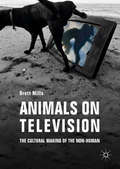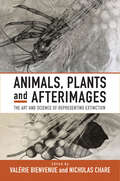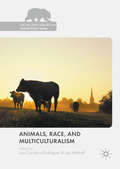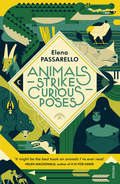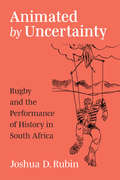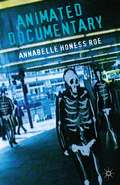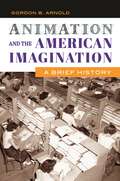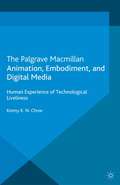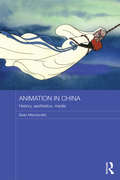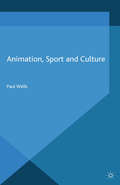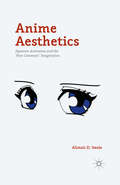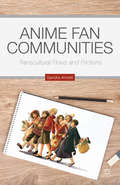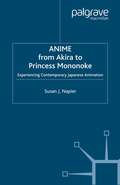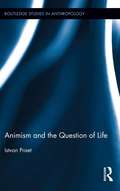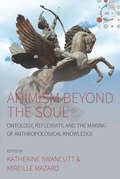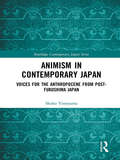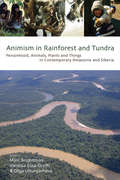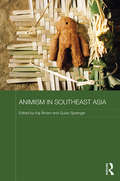- Table View
- List View
Animals on Television: The Cultural Making of the Non-Human
by Brett MillsThis book is the first in-depth study of the representation of animals on television. It explores the variety of ways animals are represented in audio-visual media, including wildlife documentaries and children’s animated series, and the consequences these representations have for those species. Brett Mills discusses key ideas and approaches essential for thinking about animals drawing on relevant debates in philosophy, politics, gender studies, humanism and posthumanism, and ethics. The chapters examine different animal representations, focusing on zoos, pets, wildlife and meat. They present case studies, including discussions of Peppa Pig, The Hunt and The Dog Whisperer. This book will be of interest to readers exploring media studies, contemporary television, animal studies, and debates about representation.
Animals, Plants and Afterimages: The Art and Science of Representing Extinction
by Valérie Bienvenue Nicholas ChareThe sixth mass extinction or Anthropocene extinction is one of the most pervasive issues of our time. Animals, Plants and Afterimages brings together leading scholars in the humanities and life sciences to explore how extinct species are represented in art and visual culture, with a special emphasis on museums. Engaging with celebrated cases of vanished species such as the quagga and the thylacine as well as less well-known examples of animals and plants, these essays explore how representations of recent and ancient extinctions help advance scientific understanding and speak to contemporary ecological and environmental concerns.
Animals, Plants and Afterimages: The Art and Science of Representing Extinction
by Nicholas Chare Valérie BienvenueThe sixth mass extinction or Anthropocene extinction is one of the most pervasive issues of our time. Animals, Plants and Afterimages brings together leading scholars in the humanities and life sciences to explore how extinct species are represented in art and visual culture, with a special emphasis on museums. Engaging with celebrated cases of vanished species such as the quagga and the thylacine as well as less well-known examples of animals and plants, these essays explore how representations of recent and ancient extinctions help advance scientific understanding and speak to contemporary ecological and environmental concerns.
Animals, Plants and Afterimages: The Art and Science of Representing Extinction
by Nicholas Chare Valérie BienvenueThe sixth mass extinction or Anthropocene extinction is one of the most pervasive issues of our time. Animals, Plants and Afterimages brings together leading scholars in the humanities and life sciences to explore how extinct species are represented in art and visual culture, with a special emphasis on museums. Engaging with celebrated cases of vanished species such as the quagga and the thylacine as well as less well-known examples of animals and plants, these essays explore how representations of recent and ancient extinctions help advance scientific understanding and speak to contemporary ecological and environmental concerns.
Animals, Race, and Multiculturalism (The Palgrave Macmillan Animal Ethics Series)
by Luís Cordeiro-Rodrigues Les MitchellThis book focuses on multiculturalism, racism and the interests of nonhuman animals. Each are, in their own right, rapidly growing and controversial fields of enquiry, but how do multiculturalism and racism intersect with the debate concerning animals and their interests? This a deceptively simple question but on that is becoming ever more pressing as we examine our societal practices in a pluralistic world. Collating the work of a diverse group of academics from across the world, the book includes writing on a wide range of subjects and addressing contemporary issues in this critical arena. Subjects covered include multiculturalism, group rights and the limits of tolerance; ethnocentrism and animals; racism and discrimination and non-Western alternatives to animal rights and welfare. The book will be of interest to researchers, lecturers and advanced students as well as range of social justice organisations, government institutions, animal activist organisations and environmental groups.
Animals, Robots, Gods: Adventures in the Moral Imagination
by Webb Keane'The book I didn't know I'd been waiting for - a fascinating trip through time and space, likening the uncanniness of A.I. not to science fiction but to religious mysteries and the near-humanness of animals. . . erudite and original' Larissa MacFarquharHow do we live ethical lives alongside others? A fascinating, mind-expanding exploration of our moral universe We have always lived with ethically significant others, whether they are the pets we keep, the gods we believe in or the machines we are endowing with life. How should we treat them as our world changes? In Animals, Robots, Gods, acclaimed anthropologist Webb Keane provides a new vision of ethics, defined less by our minds, religion or society, and more by our interactions with those around us. Drawing on ground-breaking research by fieldworkers around the world, he explores the underpinnings of our moral universe. Along the way we investigate the ethical dilemmas of South Asian animal rights activists, Balinese cockfighters, Japanese robot fanciers -- even macho cowboys. We meet a hunter in the Yukon who explains his prey generously gives itself up to him; a cancer sufferer in Thailand who sees his tumour as a reincarnated ox; a computer that gets you to confess your anxieties as if you were on the psychiatrist's couch. With charm, wit and insight, Keane offers us a better understanding of our doubts and certainties, showing how centuries of conversations between us and non-humans inform our conceptions of morality, and will continue to guide us in the age of AI and beyond.
Animals Strike Curious Poses
by Elena PassarelloBeginning with Yuka, a 39,000-year-old mummified woolly mammoth recently found in the Siberian permafrost, each of the sixteen essays in Animals Strike Curious Poses investigates a different famous animal named and immortalised by humans. Here are the starling that inspired Mozart with its song, Darwin’s tortoise Harriet, and in an extraordinary essay, Jumbo the elephant (and how they tried to electrocute him). Modelled loosely on a medieval bestiary, these witty , playful, provocative essays traverse history, myth, science and more, introducing a stunning new writer to British readers.
Animated by Uncertainty: Rugby and the Performance of History in South Africa (African Perspectives)
by Joshua D RubinIn Animated by Uncertainty, Joshua D. Rubin analyzes South African rugby through the lens of aesthetic politics. Building on 17 months of ethnographic research with rugby coaches, players, and administrators, the author argues that rugby is a form of performance and further that the qualities that define rugby shape the political ends to which the sport can be put. In this respect, Animated by Uncertainty demonstrates that theories of sporting politics cannot afford to overlook the qualities of the sports themselves, and it provides a theoretical approach to illustrate how these qualities can be studied. The book also analyzes the ways that apartheid and colonialism inhere in South African institutions and practices.Drawing inspiration from the observation that South Africans could always abandon rugby if they chose to do so, Rubin highlights how the continuing significance of rugby as a form of performance brings traces of South Africa's apartheid and colonial past into the country's contemporary political moment.
Animated Documentary
by Annabelle Honess RoeAnimated Documentary, the first book to be published on this fascinating topic, considers how animation is used as a representational strategy in nonfiction film and television and explores the ways animation expands the range and depth of what documentary can show us about the world.On behalf of the Society for Animation Studies(SAS), the Chair of the Jury announced the book as the winner of the delayed 2015 SAS McLaren-Lambart Award with the following words:'Animated Documentary is a vital addition to both animation scholarship and film studies scholarship more broadly, expertly achieving the tricky challenge of synthesising these two scholarly traditions to provide a compelling and brilliantly coherent account of the animated documentary form. At the heart of Roe’s book is the conviction that animated documentary “has the capacity to represent temporally, geographically, and psychologically distal aspects of life beyond the reach of live action” (p. 22). As a representational strategy, Roe details how animated documentary can be seen to adopt techniques of “mimetic substitution, non-mimetic substitution and evocation” in response to the limitations of live action material (p. 26). Animated Documentary will without doubt become an essential resource for many years to come for anyone interested in the intersection of animation and documentary.'
Animation and the American Imagination: A Brief History
by Gordon B. ArnoldProviding a detailed historical overview of animated film and television in the United States over more than a century, this book examines animation within the U.S. film and television industry as well as in the broader sociocultural context.From the early 1900s onwards, animated cartoons have always had a wide, enthusiastic audience. Not only did viewers delight in seeing drawn images come to life, tell fantastic stories, and depict impossible gags, but animation artists also relished working in a visual art form largely free from the constraints of the real world. This book takes a fresh look at the big picture of U.S. animation, both on and behind the screen. It reveals a range of fascinating animated cartoons and the colorful personalities, technological innovations, cultural influences and political agendas, and shifting audience expectations that shaped not only what appeared on screen but also how audiences reacted to thousands of productions. Animation and the American Imagination: A Brief History presents a concise, unified picture that brings together divergent strands of the story so readers can make sense of the flow of animation history in the United States. The book emphasizes the overall shape of animation history by identifying how key developments emerged from what came before and from the culture at large. It covers the major persons and studios of the various eras; identifies important social factors, including the Great Depression, World War II, the counterculture of the 1960s and 1970s, and the struggles for civil rights and women's rights; addresses the critical role of technological and aesthetic changes; and discusses major works of animation and the responses to them.
Animation and the American Imagination: A Brief History
by Gordon B. ArnoldProviding a detailed historical overview of animated film and television in the United States over more than a century, this book examines animation within the U.S. film and television industry as well as in the broader sociocultural context.From the early 1900s onwards, animated cartoons have always had a wide, enthusiastic audience. Not only did viewers delight in seeing drawn images come to life, tell fantastic stories, and depict impossible gags, but animation artists also relished working in a visual art form largely free from the constraints of the real world. This book takes a fresh look at the big picture of U.S. animation, both on and behind the screen. It reveals a range of fascinating animated cartoons and the colorful personalities, technological innovations, cultural influences and political agendas, and shifting audience expectations that shaped not only what appeared on screen but also how audiences reacted to thousands of productions. Animation and the American Imagination: A Brief History presents a concise, unified picture that brings together divergent strands of the story so readers can make sense of the flow of animation history in the United States. The book emphasizes the overall shape of animation history by identifying how key developments emerged from what came before and from the culture at large. It covers the major persons and studios of the various eras; identifies important social factors, including the Great Depression, World War II, the counterculture of the 1960s and 1970s, and the struggles for civil rights and women's rights; addresses the critical role of technological and aesthetic changes; and discusses major works of animation and the responses to them.
Animation, Embodiment, and Digital Media: Human Experience of Technological Liveliness
by K. ChowAnimation, Embodiment and Digital Media articulates the human experience of technology-mediated animated phenomena in terms of sensory perception, bodily action and imaginative interpretation, suggesting a new theoretical framework with analyses of exemplary user interfaces, video games and interactive artworks.
Animation in China: History, Aesthetics, Media (Routledge Contemporary China Series)
by Sean MacdonaldBy the turn of the 21st century, animation production has grown to thousands of hours a year in the People’s Republic of China (PRC). Despite this, and unlike American blockbuster productions and the diverse genres of Japanese anime, much animation from the PRC remains relatively unknown. This book is an historical and theoretical study of animation in the PRC. Although the Wan Brothers produced the first feature length animated film in 1941, the industry as we know it today truly began in the 1950s at the Shanghai Animation Film Studio (SAFS), which remained the sole animation studio until the 1980s. Considering animation in China as a convergence of the institutions of education, fine arts, literature, popular culture, and film, the book takes comparative approaches that link SAFS animation to contemporary cultural production including American and Japanese animation, Pop Art, and mass media theory. Through readings of classic films such as Princess Iron Fan, Uproar in Heaven, Princess Peacock, and Nezha Conquers the Dragon King, this study represents a revisionist history of animation in the PRC as a form of "postmodernism with Chinese characteristics." As a theoretical exploration of animation in the People’s Republic of China, this book will appeal greatly to students and scholars of animation, film studies, Chinese studies, cultural studies, political and cultural theory.
Animation in China: History, Aesthetics, Media (Routledge Contemporary China Series)
by Sean MacdonaldBy the turn of the 21st century, animation production has grown to thousands of hours a year in the People’s Republic of China (PRC). Despite this, and unlike American blockbuster productions and the diverse genres of Japanese anime, much animation from the PRC remains relatively unknown. This book is an historical and theoretical study of animation in the PRC. Although the Wan Brothers produced the first feature length animated film in 1941, the industry as we know it today truly began in the 1950s at the Shanghai Animation Film Studio (SAFS), which remained the sole animation studio until the 1980s. Considering animation in China as a convergence of the institutions of education, fine arts, literature, popular culture, and film, the book takes comparative approaches that link SAFS animation to contemporary cultural production including American and Japanese animation, Pop Art, and mass media theory. Through readings of classic films such as Princess Iron Fan, Uproar in Heaven, Princess Peacock, and Nezha Conquers the Dragon King, this study represents a revisionist history of animation in the PRC as a form of "postmodernism with Chinese characteristics." As a theoretical exploration of animation in the People’s Republic of China, this book will appeal greatly to students and scholars of animation, film studies, Chinese studies, cultural studies, political and cultural theory.
Animation, Sport and Culture
by P. WellsAnimation, Sport and Culture is a wide-ranging study of both sport and animated films. From Goofy to Goalkeepers, Wallace and Gromit to Tiger Woods, Mickey Mouse to Messi, and Nike to Nationhood, this Olympic-sized analysis looks at the history, politics, aesthetics and technologies of sport and animation from around the globe.
Anime Aesthetics: Japanese Animation and the 'Post-Cinematic' Imagination
by Alistair D. SwaleJapanese animation has been given fulsome academic commentary in recent years. However, there is arguably a need for a more philosophically consistent and theoretically integrated engagement. While this book covers the key thinkers of contemporary aesthetic theory, it aims to reground reflection on anime within the aesthetics of R.G. Collingwood.
Anime Fan Communities: Transcultural Flows and Frictions
by S. AnnettHow have animation fans in Japan, South Korea, the United States, and Canada formed communities and dealt with conflicts across cultural and geographic distance? This book traces animation fandom from its roots in early cinema audiences, through mid-century children's cartoon fan clubs, to today's digitally-networked transcultural fan cultures.
Anime from Akira to Princess Mononoke: Experiencing Contemporary Japanese Animation
by S. NapierWith the popularity of Pokemon still far from waning, Japanese animation, known as anime to its fans, has a firm hold on American pop culture. However, anime is much more than children's cartoons. It runs the gamut from historical epics to sci-fi sexual thrillers. Often dismissed as fanciful entertainment, anime is actually quite adept at portraying important social and cultural issues like alienation, gender inequality, and teenage angst. This book investigates the ways that anime presents these issues in an in-depth and sophisticated manner, uncovering the identity conflicts, fears over rapid technological advancement, and other key themes present in much of Japanese animation.
Animism and the Question of Life (Routledge Studies in Anthropology)
by Istvan PraetThe central purpose of this book is to help change the terms of the debate on animism, a classic theme in anthropology. It combines some of the finest ethnographic material currently available (including firsthand research on the Chachi of Ecuador) with an unusually broad geographic scope (the Americas, Asia, and Africa). Edward B. Tylor originally defined animism as the first phase in the development of religion. The heyday of cultural evolutionism may be over, but his basic conception is commonly assumed to remain valid in at least one respect: there is still a broad consensus that everything is alive within animism, or at least that more things are alive than a modern scientific observer would allow for (e.g., clouds, rivers, mountains) It is considered self-evident that animism is based on a kind of exaggeration: its adherents are presumed to impute life to this, that and the other in a remarkably generous manner. Against the prevailing consensus, this book argues that if animism has one outstanding feature, it is its peculiar restrictiveness. Animistic notions of life are astonishingly uniform across the globe, insofar as they are restricted rather than exaggerated. In the modern Western cosmology, life overlaps with the animate. Within animism, however, life is always conditional, and therefore tends to be limited to one’s kin, one’s pets and perhaps the plants in one’s garden. Thus it emerges that "our" modern biological concept of life is stranger than generally thought.
Animism and the Question of Life: Animism And The Question Of Life (Routledge Studies in Anthropology)
by Istvan PraetThe central purpose of this book is to help change the terms of the debate on animism, a classic theme in anthropology. It combines some of the finest ethnographic material currently available (including firsthand research on the Chachi of Ecuador) with an unusually broad geographic scope (the Americas, Asia, and Africa). Edward B. Tylor originally defined animism as the first phase in the development of religion. The heyday of cultural evolutionism may be over, but his basic conception is commonly assumed to remain valid in at least one respect: there is still a broad consensus that everything is alive within animism, or at least that more things are alive than a modern scientific observer would allow for (e.g., clouds, rivers, mountains) It is considered self-evident that animism is based on a kind of exaggeration: its adherents are presumed to impute life to this, that and the other in a remarkably generous manner. Against the prevailing consensus, this book argues that if animism has one outstanding feature, it is its peculiar restrictiveness. Animistic notions of life are astonishingly uniform across the globe, insofar as they are restricted rather than exaggerated. In the modern Western cosmology, life overlaps with the animate. Within animism, however, life is always conditional, and therefore tends to be limited to one’s kin, one’s pets and perhaps the plants in one’s garden. Thus it emerges that "our" modern biological concept of life is stranger than generally thought.
Animism beyond the Soul: Ontology, Reflexivity, and the Making of Anthropological Knowledge (Studies in Social Analysis #6)
by Katherine Swancutt and Mireille MazardHow might we envision animism through the lens of the ‘anthropology of anthropology’? The contributors to this volume offer compelling case studies that demonstrate how indigenous animistic practices, concepts, traditions, and ontologies are co-authored in highly reflexive ways by anthropologists and their interlocutors. They explore how native epistemologies, which inform anthropological notions during fieldwork, underpin the dialogues between researchers and their participants. In doing so, the contributors reveal ways in which indigenous thinkers might be influenced by anthropological concepts of the soul and, equally, how they might subtly or dramatically then transform those same concepts within anthropological theory.
Animism in Contemporary Japan: Voices for the Anthropocene from post-Fukushima Japan (Routledge Contemporary Japan Series)
by Shoko Yoneyama‘Postmodern animism’ first emerged in grassroots Japan in the aftermath of mercury poisoning in Minamata and the nuclear meltdown in Fukushima. Fusing critiques of modernity with intangible cultural heritages, it represents a philosophy of the life-world, where nature is a manifestation of a dynamic life force where all life is interconnected. This new animism, it is argued, could inspire a fundamental rethink of the human-nature relationship. The book explores this notion of animism through the lens of four prominent figures in Japan: animation film director Miyazaki Hayao, sociologist Tsurumi Kazuko, writer Ishimure Michiko, and Minamata fisherman-philosopher Ogata Masato. Taking a biographical approach, it illustrates how these individuals moved towards the conclusion that animism can help humanity survive modernity. It contributes to the Anthropocene discourse from a transcultural and transdisciplinary perspective, thus addressing themes of nature and spirituality, whilst also engaging with arguments from mainstream social sciences. Presenting a new perspective for a post-anthropocentric paradigm, Animism in Contemporary Japan will be useful to students and scholars of sociology, anthropology, philosophy and Japanese Studies.
Animism in Contemporary Japan: Voices for the Anthropocene from post-Fukushima Japan (Routledge Contemporary Japan Series)
by Shoko Yoneyama‘Postmodern animism’ first emerged in grassroots Japan in the aftermath of mercury poisoning in Minamata and the nuclear meltdown in Fukushima. Fusing critiques of modernity with intangible cultural heritages, it represents a philosophy of the life-world, where nature is a manifestation of a dynamic life force where all life is interconnected. This new animism, it is argued, could inspire a fundamental rethink of the human-nature relationship. The book explores this notion of animism through the lens of four prominent figures in Japan: animation film director Miyazaki Hayao, sociologist Tsurumi Kazuko, writer Ishimure Michiko, and Minamata fisherman-philosopher Ogata Masato. Taking a biographical approach, it illustrates how these individuals moved towards the conclusion that animism can help humanity survive modernity. It contributes to the Anthropocene discourse from a transcultural and transdisciplinary perspective, thus addressing themes of nature and spirituality, whilst also engaging with arguments from mainstream social sciences. Presenting a new perspective for a post-anthropocentric paradigm, Animism in Contemporary Japan will be useful to students and scholars of sociology, anthropology, philosophy and Japanese Studies.
Animism in Rainforest and Tundra: Personhood, Animals, Plants and Things in Contemporary Amazonia and Siberia
by UnknownAmazonia and Siberia, classic regions of shamanism, have long challenged ‘western’ understandings of man’s place in the world. By exploring the social relations between humans and non-human entities credited with human-like personhood (not only animals and plants, but also ‘things’ such as artifacts, trade items, or mineral resources) from a comparative perspective, this volume offers valuable insights into the constitutions of humanity and personhood characteristic of the two areas. The contributors conducted their ethnographic fieldwork among peoples undergoing transformative processes of their lived environments, such as the depletion of natural resources and migration to urban centers. They describe here fundamental relational modes that are being tested in the face of change, presenting groundbreaking research on personhood and agency in shamanic societies and contributing to our global understanding of social and cultural change and continuity.
Animism in Southeast Asia (Routledge Contemporary Southeast Asia Series)
by Guido Sprenger Kaj ÅrhemAnimism refers to ontologies or worldviews which assign agency and personhood to human and non-human beings alike. Recent years have seen a revival of this concept in anthropology, where it is now discussed as an alternative to modern-Western naturalistic notions of human-environment relations. Based on original fieldwork, this book presents a number of case studies of animism from insular and peninsular Southeast Asia and offers a comprehensive overview of the phenomenon – its diversity and underlying commonalities and its resilience in the face of powerful forces of change. Critically engaging with the current standard notion of animism, based on hunter-gatherer and horticulturalist societies in other regions, it examines the roles of life forces, souls and spirits in local cosmologies and indigenous religion. It proposes an expansion of the concept to societies featuring mixed farming, sacrifice and hierarchy and explores the question of how non-human agents are created through acts of attention and communication, touching upon the relationship between animist ontologies, world religion, and the state. Shedding new light on Southeast Asian religious ethnographic research, the book is a significant contribution to anthropological theory and the revitalization of the concept of animism in the humanities and social sciences.
